This review is derived from what was originally a comparison review of several mirrorless cameras on bythom.com. As such, it's abbreviated from my usual form.
Note: the Sony NEX-5N upgraded the sensor slightly, added an optional EVF, a touchscreen, and a few other very modest changes but essentially performs similarly to this reviewed camera. The Sony NEX-5R is the most recent update, and added phase detection autofocus and WiFi. Focus performance on a NEX-5R will be better than I write about here, but again, the NEX-5R will perform in most ways like the original NEX-5 I reviewed here. Because the changes have been small and gradual, I'll likely not write specific NEX-5N and NEX-5R reviews and wait for a major change.
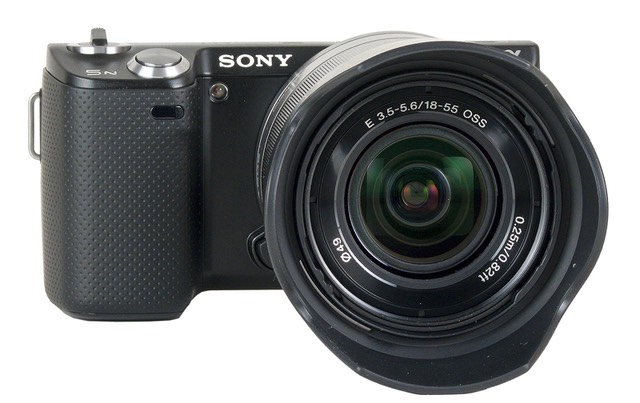
What is It?
The Sony NEX-5 was a bit of a surprise: Sony's APS 14mp DSLR sensor in a very small mirrorless camera body. The camera is so small, the necessary lens size (to cover the large APS image circle) tends to make the lens dominate the camera body when you see it (see image, above). The camera with the 18-55mm kit lens is basically the size of a small soap bar with the big barrel of an DSLR lens mounted on the front of it.
A lot of people dismiss the NEX-5 (and other Sony NEX models) simply because of that: the lenses are too big, they say. If you're going to try to stick the camera into a jacket pocket, that very well may be true, but frankly the overall displacement, even with the big kit lens, isn't all that much and the size/weight is far lower than the low-end DSLRs. But if "small camera/small lens" is what you want, then yes, you need to look at the m4/3 or the Nikon 1 models, I think.
But that sensor: because of its APS size, you should expect it to perform like a DSLR (I won't make you wait: it does).
Sony didn't just put a different sensor into their mirrorless camera, though: they completely reinvented the camera. To some that's a good thing, others will dislike it.
While this cuts a bit to the handling side, we need to discuss it hear in the feature review: the NEX-5 doesn't have conventional controls. No mode dial. No direct dedicated aperture or shutter speed control. No ISO or WB buttons. In fact, not much of any control. One of the distinguishing traits of the NEX-5 design is that it has three buttons and a dial on the back for controlling, well, virtually everything. I can tell you right up front that this will be the real deal killer for some of you. If you want traditional, don't buy the NEX-5. On the other hand, don't dismiss this new style out of hand. Interestingly, it's very close to something I proposed a long time ago. Having everything with a dedicated button can be just as disruptive as having no buttons. What Sony's attempted to do I commend them for: come up with a consistent, useful, but simplified control system.
Sony's changes didn't stop at the UI, though. The 3" LCD panel is tiltable (not swivel, just up and down). On such a small camera that adds a flexibility that's very useful.
Another of the "changes" is the lack of a hot shoe, but instead a propreitary accessory slot. Nice try, Sony, but no thanks. While the little hidden door on the top of the camera makes for a very nice, clean profile while not using an accessory, the actual design of this "slot" is quite klunky in actual use (see How's it Handle, below). Moreover, we get to buy new everything: flashes, optical viewfinders, you name it.
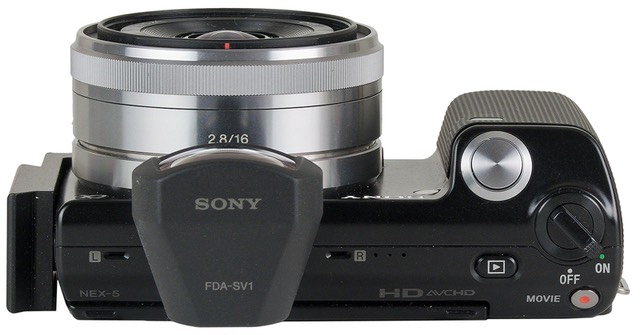
They didn't stop there, though. The tripod socket is a bit unique, too, as it is on a small bulge that sticks below the camera. That makes using any standard plates almost impossible. Fortunately, third parties have come to the rescue. If you use Arca Swiss style mounts like I do, then get the JTEC L-bracket for the Sony NEX-5 (hint: you can get it at B&H). Not only does it take care of the problem, but it's small and fits the style of the camera nicely.
I give Sony full marks for rethinking cameras here. They didn't build a "bigger compact with changeable lenses" (I'm looking at you Nikon), nor did they just build a smaller DSLR (yes, I mean you Panasonic). They actually looked at the size and goal of an intermediary camera and tried to build something that fit into that space. Bravo.
How's it Handle?
The Sony NEX-5 is going to be a camera you love the handling on or for which you hate the handling. As I noted above, everything is pretty much controlled by three buttons and a Direction pad/dial. With the updated software you can customize what those buttons do in some useful ways that bring key controls closer to front-line duty.
Here's the rub: if you're a nervous shooter that bounces around amongst exposure modes and camera settings, you're probably not going to like the Sony interface. At least not initially. Exposure compensation, ISO, White Balance, and a host of other things are buried a couple of levels down in the menu system (though it does remember which area you were in, so you're really only one level away most of the time). Even the Version 3 software update, which allows you to customize the "soft" buttons, doesn't fully solve the problem, as it moves Mode down into the menus to get other things to the main button. On the plus side, there's a clear hierarchy and the language used is clear. But this is mostly a menu-driven camera, even with the recent firmware change.
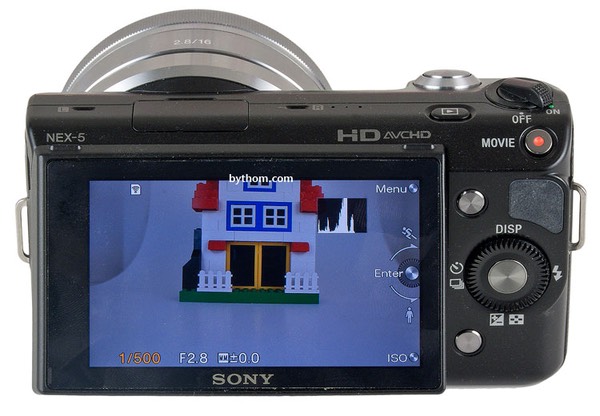
The Shooting Tips aspect of the camera shows that Sony was aiming this camera at the compact consumer moving up, not the DSLR user moving down, so I'm not going to ding them on it, especially since we can now program that button for something else. Personally, I'm not a shooter that's always tweaking anything other than exposure and sometimes ISO, so I'm not put off by the design (much). Indeed, the more I use it, the more I like it, as those three buttons are very conveniently located. So well located that I was shooting comfortably from a horse with the camera.
The compositional area on the LCD is either reduced or compromised (your choice) by Sony's having to put button/dial reminders on the right side of the display, though, so this isn't really a 3" display in practice, it's a smaller one or a cluttered one, again, your choice.
I get what Sony was trying to do with the interface, but it's not the interface most serious shooters would have chosen.
I received a lot of emails about my "pan" of the NEX-5 when I first wrote this, particularly on my handling comments. I'm not sure I'd label my comments a "pan." The Sony is different and my point is that difference can be a liability in shooting to newcomers. One of my UI tests is to see how fast I can change exposure mode, shutter speed/aperture, white balance, and ISO before taking another shot. This is what I'd call the "nervous shooter." And, yes, there are times when that is exactly what you need to do before taking your next shot. It's in this "need to make a number of major settings" condition that the Sony's UI starts to be a bit cumbersome.
Yet, if you take out one of those things (exposure mode change), the version 3 firmware allows you to set the camera up as fast as the others.
One other handling comment I didn't make in the first version of this review but influenced my comments on handling: power on delay. The Sony has a significant one. In fact, if the color LCD has gone black (into power save), there's still a tangible delay in taking a picture even with the camera turned on. The purpose of a camera is to take pictures. Picture opportunities can be so spontaneous that they require near instant response. That's one of the reasons why we pros talk about shutter lag, and debate about the differences between a few nanoseconds. Unfortunately, the Sony's power-on lag is more like a half second, which is enough to miss photos. In this, it is very consumer compact camera-ish.
Since mirrorless cameras are bigger than compact cameras (though the Sony body comes close to compact sized), there's the issue of "grip." The NEX-5 is definetly right-handed, by the way. Left-handers aren't going to like it. Still, this small Sony has one of the most solid one-hand grip positions you'll find. Too bad about the only control you can reach is the top button when you're in one-hand mode, which may not be useful to what you want to set.
How's it Perform?
The Sony
NEX-5 has it's pluses and minuses when it comes to focus. With the 16mm
pancake lens it is remarkably fast (less so with the kit lens) unless it
hits broad expanses of low contrast areas. Interesting, low contrast
just slows the Sony down, it doesn't keep it from finding focus
eventually as with some compact cameras. Continuous AF is interesting.
It's so jittery that sometimes the LCD view is nauseating (things seem
to pulse ever so slightly, especially at the edges of the frame for some
reason). Yet the jitter is so small in size that the camera is actually
doing a reasonable job of following focus. But here's the rub. Let's
change to manual focus. Button, navigate to camera, navigate menu until
you've found AF/MF Select, enter sub-menu, select MF. Moreover, moving
between SAF, CAF, and MF isn't all in the same place (more menu items to
navigate to). [It was pointed out to me that I didn't understand DMF.
That's correct, and that's probably due to something else I didn't
mention: the 82-page instruction manual is terrible. But DMF does indeed
get the Sony up to same level for manual focus as the others, you just
have to find it in the menus.] So you don't suddenly jump between
autofocus and manual focus on this camera. Manual focus itself should
have been a slam dunk with the highest resolution LCD in the bunch, but
it really only gets to the same levels as some of the lesser mirrorless cameras.
Pity.
At low ISO, the NEX-5 delivers everything you'd expect from a DSLR. That's to be expected, as it's using the same sensor as some DSLRs. At high ISO values, the NEX-5 is a clear winner. ISO 3200 images clean up with very little effort and keep their edge acuity, too. The NEX-5 has a clear one stop or more advantage over virtually all of its mirrorless competitors, even the APS-sensor Samsung NX models. I'd be happy to press the Sony to ISO 1600 in regular shooting, and not afraid of ISO 3200 or even ISO 6400 if I needed it.
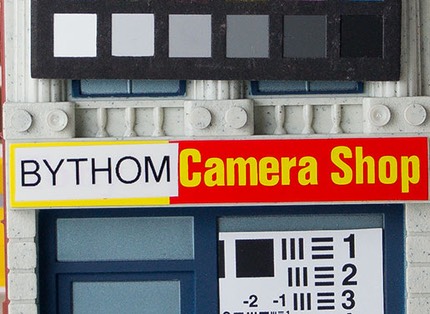
Base ISO
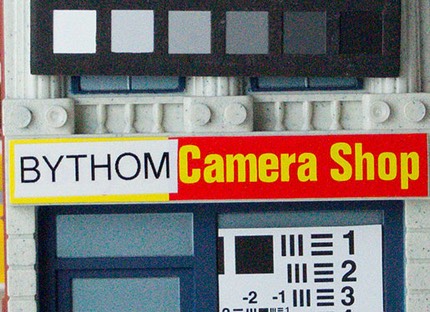
ISO 3200, no noise reduction
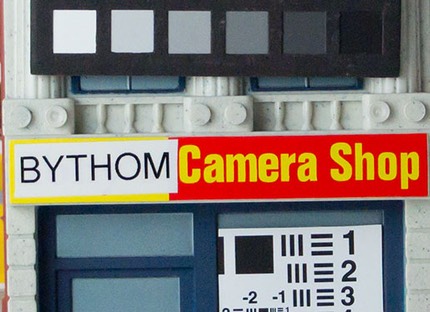
ISO 3200, noise reduction turned on
Final Thoughts
I can
recommend the Sony NEX-5 with some reservation about the UI: not everyone will like it. I happen to like it just fine. The NEX-5 is excellent in image quality, especially if you need higher ISO
values, and the 16mm f/2.8 lens makes for a very compact wide angle walk
around camera. Sony's problem is three-fold, and you need to consider
all these things before committing, I think. First, like Samsung and Nikon, the
lenses just aren't there yet; you have too few good lens choices, even with the Alpha mount adapter. Second, many of the lenses just absolutely
dwarf the camera body, and that starts to make the camera less
desirable as a "compact." Finally, the non-standard user interface and
simplified control system is either going to get you swearing at the
camera or you're going to learn to like it. I've learned to get along
with it just fine, but I can't predict whether you will, so don't buy
the Sony without actually trying it at a store first. And don't just
give it a once over: actually try assigning the buttons and using the
camera for a bit before giving up on it.
2018: this model is out of production and no longer available new. But used copies can easily be found. Also look at a current model, which would be the A6100, or other A6xxx model.
